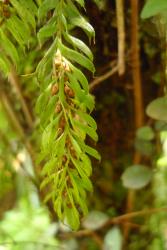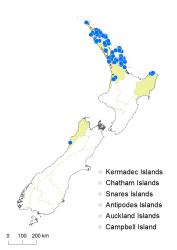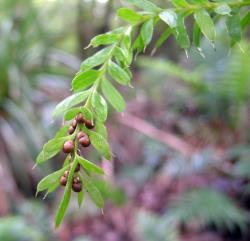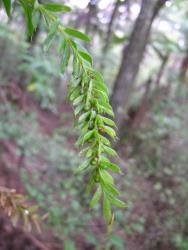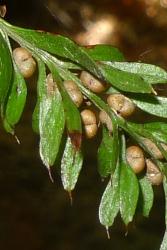- = Tmesipteris tannensis var. elongata Sahni, Philos. Trans., Ser. B 213: 143, pl. 5, fig. 5-6 (1925) nom. illeg.
Epiphytic ferns. Aerial stems pendent, 40–270 mm long, 10–35 mm wide, unbranched or rarely 1-branched, of indeterminate growth terminated by large sterile leaf or sporophyll. Leaves narrowly oblong or narrowly ovate, usually sigma-shaped, spirally arranged, shiny green on both surfaces, coriaceous; the longest 8–20 mm long, 2–4 mm wide, just above or just below mid-stem; apices slightly emarginate, truncate or cuspidate, with a mucro 1.5–3.5 mm long. Sporophylls mostly in the distal half of the stem or sometimes throughout except for the lowermost part. Synangia 2.5–5 mm long, 1–2.5 mm high; lobes often unequal in size or occasionally equal, round-ended; the lower surface of each lobe appressed to the subtending leaf margin along its length.
This species is recognised by its generally sigma-shaped leaves which are narrower than in other species and with a longer mucro tip. The synangia are usually located in the distal half of the stem, and the lobes are often unequal in size, with rounded ends.
North Island: Northland, Auckland, Gisborne.
South Island: Western Nelson.
Altitudinal range: 0–400 m.
Tmesipteris sigmatifolia occurs throughout Northland and Auckland, as far south as Thames, with outlying populations on Mt Pirongia and near Kāwhia Harbour, and isolated records in the far eastern Bay of Plenty between Waihau Bay and Pōtaka. In the South Island, there are very sporadic and imprecisely located 19th century collections of the species from the Maitai Valley, Nelson and in Westland (Chinnock 1975, in overseas herbaria), but only one 20th century collection from the Pororari River, Westland (CHR 500815). In the North Island it grows to 300 m or more in the Puketi, Herekino and Maungataniwha Forests, and up to 400 m on Mt Pirongia and on Great Barrier Island.
Also New Caledonia.
Tmesipteris sigmatifolia grows epiphytically on tree fern trunks, most commonly on Cyathea dealbata and Dicksonia squarrosa, but also occasionally on Cyathea medullaris, Dicksonia lanata, and, at higher altitudes, on Cyathea smithii. It has been recorded once growing in litter at the base of a kauri (CHR 302370). It occurs in kauri, podocarp, broadleaved and old kānuka forests in northern New Zealand.
n = 104 (Brownsey & Lovis 1987).



